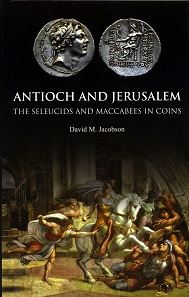by Ursula Kampmann
translated by Annika Backe
February 11, 2016 – A word in advance: Everybody unwilling to question his or her established knowledge and integrate new aspects should keep away from this book. This work calls into question much of what we think we know for sure about the Maccabean Revolt.
David M. Jacobson, Antioch and Jerusalem. The Seleucids and Maccabees in Coins. Spink, London, 2015. 176 p., 14.5 x 22.2 cm, color illustrations throughout. Hardcover. 978-1-907427-54-1. GBP 30.
Every year Jewish families celebrate Hanukkah, the Festival of Lights. It is a kind of historic day of remembrance, just as Pessah or Sukkot, the Feast of Booths. Hanukkah commemorates the rededication of the Temple in Jerusalem. According to Jewish belief, the Seleucid king Antiochus IV had profaned the temple by equating Yahweh with Zeus. In 164 BC, the traditional temple service was resumed. A miracle is connected with it that explains why the festival takes eight days: When they wanted to light the seven-branched menorah the only thing they found was a single bowl with blessed oil. That was enough to light the huge lamp for just one day – ordinarily. Miraculously, this single bowl contained enough for eight days, these eight days it took to get new, blessed oil…
Hanukkah, therefore, is a very delicate matter. Jewish children are told the story of Hanukkah from very early on. Nobody likes to see his favorite childhood stories confronted with reality. Yet David M. Jacobson is the right author to deal with this topic. He is an expert in Jewish history and archaeology and Honorary Research Fellow in the Department of Hebrew and Jewish Studies at University College London. He is the editor of Palestine Exploration Quarterly and has written several important books on Jewish archaeology and history.
He deserves great merit for not restricting his history to Jews and Seleucids. He sees the whole picture, also taking account of the neighboring peoples and the conflict between the Hellenistic rulers and Rome. Thus, his findings gain a depth and plausibility that can never be found with the black-and-white descriptions that are based only on 1 Maccabees and Flavius Josephus.
Naturally, coins are the most important source for reconstructing the historical events. The author exploits them to a great extent. There is hardly any page that does not feature a coin. The layout is very good indeed. Accompanied by a comment, the coins are shown in a separate column next to the text. The numerous source quotations are separated from the text by a darker background. When looking at the many pictures and maps of archaeological testimonies, you get an idea of how diverse the sources are that provide the basis for David M. Jacobson’s remarks.
There is much to be gained from reading this history. “The Seleucids and Maccabees in Coins” is another proof for the fact that every era writes its own history. And in an era when we realize that “right” and “wrong”, “good” and “evil” are often only a matter of perspective the time was right to give a new interpretation of the history of the Maccabean Revolt.
You may order the book directly at Spink.





